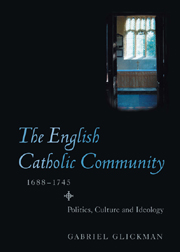Book contents
- Frontmatter
- Contents
- List of illustrations
- Acknowledgements
- Abbreviations
- Introduction
- 1 English Catholics and the Glorious Revolution of 1688
- 2 The making of the Catholic gentry in England and in exile
- 3 Conscience, politics and the exiled court: the creation of the Catholic Jacobite manifesto 1689–1718
- 4 Catholic politics in England 1688–1745
- 5 Unity, heresy and disillusionment: Christendom, Rome and the Catholic Jacobites
- 6 The English Catholic clergy and the creation of a Jacobite Church
- 7 The English Catholic reformers and the Jacobite diaspora
- Conclusion
- Appendices
- Bibliography
- Index
Conclusion
Published online by Cambridge University Press: 12 September 2012
- Frontmatter
- Contents
- List of illustrations
- Acknowledgements
- Abbreviations
- Introduction
- 1 English Catholics and the Glorious Revolution of 1688
- 2 The making of the Catholic gentry in England and in exile
- 3 Conscience, politics and the exiled court: the creation of the Catholic Jacobite manifesto 1689–1718
- 4 Catholic politics in England 1688–1745
- 5 Unity, heresy and disillusionment: Christendom, Rome and the Catholic Jacobites
- 6 The English Catholic clergy and the creation of a Jacobite Church
- 7 The English Catholic reformers and the Jacobite diaspora
- Conclusion
- Appendices
- Bibliography
- Index
Summary
Three decades after the last shot was fired in the siege of Preston, the Jacobite challenge was once again pressed upon the consciousness of the nation. During the course of the 1745 rebellion, there were significant signs that elements within the English Catholic community had not abandoned the dream of reversing the Revolution, and reclaiming their perceived birthright within the kingdom on the back of Stuart re-conquest. In the East Anglian recusant enclaves of Norwich, Wymondham and Bungay, Catholic priests were reported to be exhorting their flock to rebellion. In Yorkshire, the duke of Norfolk's steward, Andrew Blyde, rode out to rally under the standard of Prince Charles Edward. Further north, military exertions by members of the Strickland, Charlton, Collingwood and Clavering families showed that old traditions of Stuart royalist action would take more than one generation to wither away. These scattered bursts of insurrection represented a slight threat compared to the rising of 1715, or the organised system of weapon-holding and conspiracy that linked together recusant manors during the reign of William III. However, they served to hint that, just because the Catholic community had been demilitarised by the recriminations after 1715, it was not necessarily drained of fervour.
While Jacobite conspiracy slowly diminished, Jacobite convictions would still linger into later decades in the English recusant consciousness. In Lancashire, Anne Hawarden and Mary Standish exchanged political poetry during the '45, and ran to salute the rebel troops on their southward march.
- Type
- Chapter
- Information
- The English Catholic Community, 1688–1745Politics, Culture and Ideology, pp. 252 - 258Publisher: Boydell & BrewerPrint publication year: 2009

